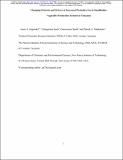| dc.description.abstract | Pesticides use has become a key component of smallholder horticulture production. Therefore, dynamics in pesticides handling need to be ascertained. This study assessed drivers of pesticides use and determinants of changing patterns of pesticides handling practices in smallholder vegetable systems. Data were collected from 385 farmers from Iringa, Arusha, Manyara, and Kilimanjaro regions in Tanzania through an in-depth survey and field observations. A binary probit model was used to derive factors fostering increased pesticides use. Results showed that 47.9 % of all pesticides were wrongly used. Most farmers (88.6%) lacked knowledge of pest control and 88.9% were unaware of safety practices. Disposal methods of empty pesticides foster occupational and environmental exposure (58%). There was an increasing trend in pesticides use (58.4%), accompanied by changing pesticides formulations. Over 60 pesticides with 29 different formulations were used. Mixing pesticides (71.2%), high dose rates with increased frequency of application were observed. Pesticides under Class II WHO hazard (68.9%) dominated. Extremely hazardous (Class Ia) and highly hazardous (Class Ib) were also used. Binary probit model showed that number of crops grown, pesticides mixing, and region contributed positively to the likelihood of increased pesticides use while farmers’ perception of effectiveness of pesticides, lack of access to safe use information, poor use of safety gears and inability to read pesticides labels had a negative impact. The fate of pesticides use in smallholder vegetable production systems is therefore the culmination of serious health and environmental implications. Excessive pesticides use escalated by increased number of crops, improper use of PPE, and pesticides mixing practices subjects the general population to pesticides environmental exposure thereby jeopardizing sustainability of smallholder vegetable production in Tanzania. Regular training to farmers and extension officers on current and emerging issues on pests and pesticide safe use is vital. | en_US |

